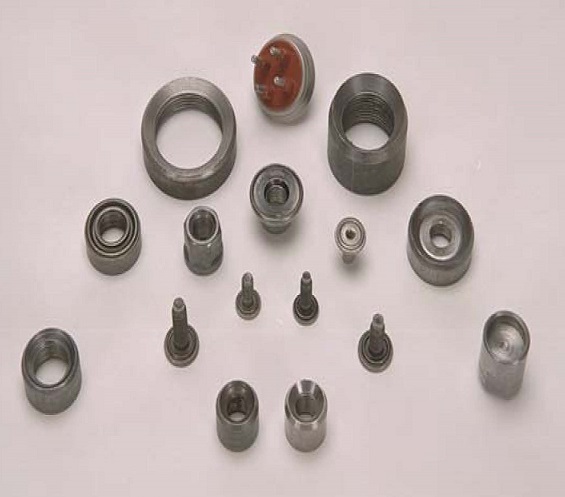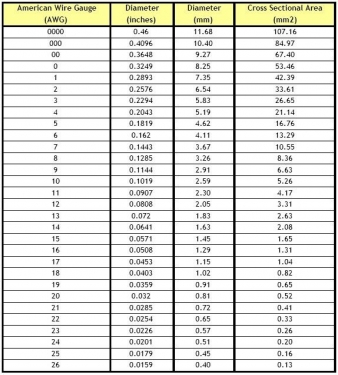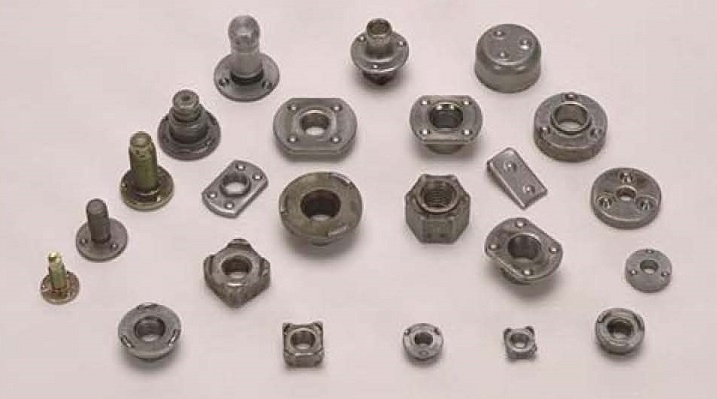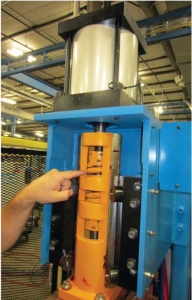
Projection Welding
Questions and Answers
Ring projections can be a round radius faced annular ring on one face of the part. Frequently the ring is a “V” shaped ring on the face of the part. Be it a ring or individual projections the process is the same. The projection design concentrates the force and heat on the part and heat will generate there when current is applied. The connection on the top of a water heater is an example we are all familiar with. This annular projection prevents the connection from leaking water during use.

TYPICAL RING PROJECTIONS
To develop the process to make this type of weld, some starting information is helpful. There is not much available. THE WELDING INSTITUTE in the UK “TWI” does have some basic data available.
They offered some information on general design considerations. Most importantly they offered estimated values of force, time and current.
Cross wire welding is a form of projection welding. When two wires are crossed that is a point contact. The heat and force are concentrated at that point contact. Even welding a wire to a sheet is a projection weld concentrated in a line point contact. Weld schedules are available in the literature for this type of operation.
The American Wire Gage Chart:

Knowing the wire size one can look up a possible weld schedule in:
AWS Standard C1.1 Recommended Practices For Resistance Welding
Assorted projection welding nuts are shown below. They are being welded in industry every day for cars, appliances, office equipment and many other products. Proper welding is imperative since many important items are being fastened to these nuts.

ASSORTED WELD NUTS
There is very little published data available on the subject of nut welding fasteners. A few articles have been written. Some data is available on the website of fastener manufacturers.
Two articles can be found in:
WELDING JOURNAL: RWMA Q & A JANUARY & MARCH 2011 – “QUALITY OF FORGED PROJECTION WELD NUTS”
This could be rephrased to be - What are the parameters of a projection welding process? In this case what parameters should be checked besides pressure, current and time when projection welding (PCT)? Before we move on, these three cannot be passed over. If the control or force application is not functioning properly the projection weld will not meet specification. The appropriate components must be part of the regular preventive maintenance list and checked daily, weekly, monthly as prescribed. A guide to machine and equipment maintenance can be found in:
AWS J1.2 GUIDE TO INSTALLATION AND MAINTENANCE OF RESISTANCE WELDIGN MACHINES
The first step in developing a process is to know what is to be welded. What is the material, it’s temper, coating, thickness and cleanliness. The number of welds. Where and the quality requirements.
Now let’s look at the equipment to be used for the job. Several machine set up items must be addressed before the schedule is developed. In projection welding normally several projections or even a full ring projection are being welded at the same time. For this to occur successfully the tooling and machine have to be set up properly and operating efficiently. Important factors are:
FORCE APPLICATION AND FOLLOW-UP
ALIGNMENT
PROJECTION SHAPE, SIZE & CONSISTENCY
ELECTRODE MATERIAL AND CONFIGURATION
FORCE APPLICATION AND FOLLOW-UP: The force must be applied perpendicular to the plane of the weld faying surface. A rocker arm which welds with an arc motion is not appropriate for projection welding. Straight acting press welders, table mounted weld guns with suitable force will do. The source of the force must be consistent and fast. The servo or cylinder must move smoothly with no hesitation. Fast follow up refers to the ability to maintain full force as the projection begins to collapse. If the machine does not maintain/follow up with full force at the moment the nugget begins to collapse and could be solidifying the weld strength will be compromised. Low inertia cylinders, machines and servos are manufactured for this purpose. Low inertia holders are also available to retro fit slower machines. This is a case for periodic preventive maintenance to insure that a cylinder, servo is always in good working order and not starting to hang up.


LOW INERTIA WELDER FAST FOLLOWUP HOLDER
Page 8 of 14
Have a Question?
Do you have a question that is not covered in our knowledgebase? Do you have questions regarding the above article? Click here to ask the professor.
